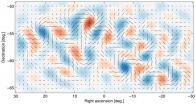(Press-News.org) New research in Geophysical Research Letters examines earthquake swarms caused by mounting volcanic pressure which may signal an imminent eruption. The research team studied Augustine Volcano in Alaska which erupted in 2006 and found that precursory earthquakes were caused by a block in the lava flow.
36 hours before the first magmatic explosions, a swarm of 54 earthquakes was detected across the 13-station seismic network on Augustine Island. By analyzing the resulting seismic waves, the authors found that the earthquakes were being triggered from sources within the volcano's magma conduit.
"Our article talks about a special type of volcanic earthquake that we think is caused by lava breaking, something that usually can't happen because lava is supposed to flow more like a liquid, rather than crack like a piece of rock," said Dr. Helena Buurman from the University of Alaska Fairbanks. "Much like breaking a piece of chewing gum by stretching it really fast, lab tests show that hot lava can break when stretched quickly enough under certain pressures like those that you might find in the conduit of a volcano. "
The authors found that over the course of the two hour swarm, the earthquakes' focus moved 35 meters deeper down into the magma conduit, an indication that the conduit was becoming clogged. The resulting buildup of pressure may have contributed to the explosive eruption the next day.
"We think that these earthquakes happened within the lava that was just beginning to erupt at the top of Augustine. The earthquakes show that the lava flow was grinding to a halt and plugging up the system. This caused pressure to build up from below, and resulted in a series of large explosions 36 hours later," concluded Dr. Buurman. "We believe that these types of earthquakes can be used to signal that a volcano is becoming pressurized and getting ready to explode, giving scientists time to alert the public of an imminent eruption. "
INFORMATION: END
Earthquakes caused by clogged magma a warning sign of eruption, study shows
2014-03-18
ELSE PRESS RELEASES FROM THIS DATE:
Eat more, die young: Why eating a diet very low in nutrients can extend lifespan
2014-03-18
A new evolutionary theory in BioEssays claims that consuming a diet very low in nutrients can extend lifespan in laboratory animals, a finding which could hold clues to promoting healthier ageing in humans.
Scientists have known for decades that severely restricted food intake reduces the incidence of diseases of old age, such as cancer, and increases lifespan.
"This effect has been demonstrated in laboratories around the world, in species ranging from yeast to flies to mice. There is also some evidence that it occurs in primates," says lead author, Dr Margo Adler, ...
Follow the ant trail for drug design
2014-03-18
This news release is available in German. The path to developing new drugs is a long one. If a target is identified for a new active agent – for instance a particular protein that plays a key role in a disease – an active molecule that binds to the target must then be developed. Pharmaceutical companies trawl through their collections of chemicals for substances that act on the target protein in the desired fashion. However, these compounds are often just the starting point for a long process of adjustment and testing. Chemists use computer simulations to design new ...
Democrats, Republicans see each other as mindless -- unless they pose a threat
2014-03-18
We are less likely to humanize members of groups we don't belong to—except, under some circumstances, when it comes to members of the opposite political party. A study by researchers at New York University and Harvard Business School suggests that we are more prone to view members of the opposite political party as human if we view those individuals as threatening.
"It's hardly surprising that we dehumanize those who are not part of our groups," says Jay Van Bavel, an assistant professor in NYU's Department of Psychology and one of the study's co-authors. "However, what ...
Research on the protein gp41 could help towards designing future vaccinations against HIV
2014-03-18
This news release is available in Spanish. Researchers from the University of Granada have discovered, for the first time, an allosteric interaction (that is, a regulation mechanism whereby enzymes can be activated or de-activated) between this protein, which forms part of the sheath of the Human Immunodeficiency Virus (HIV) and the antibody 2F5 (FAB), a potent virus neutralizer. This important scientific breakthrough could help specialists to understand the mechanisms behind generating immune responses and help towards the design of future vaccines against the HIV ...
First direct evidence of cosmic inflation
2014-03-18
Almost 14 billion years ago, the universe we inhabit burst into existence in an extraordinary event that initiated the Big Bang. In the first fleeting fraction of a second, the universe expanded exponentially, stretching far beyond the view of our best telescopes. All this, of course, was just theory.
Researchers from the BICEP2 collaboration today announced the first direct evidence for this cosmic inflation. Their data also represent the first images of gravitational waves, or ripples in space-time. These waves have been described as the "first tremors of the Big Bang." ...
Immunologists present improved mass spectrometric method for proteomic analyses
2014-03-18
When it comes to analyzing cell components or body fluids or developing new medications, there is no way around mass spectrometry. Mass spectrometry is a highly sensitive method of measurement that has been used for many years for the analysis of chemical and biological materials. Scientists at the Institute of Immunology of the University Medical Center of Johannes Gutenberg University Mainz (JGU) have now significantly improved this analytical method that is widely employed within their field. They have also developed a software program for the integrated analysis of ...
UNH research: Positive memories of exercise spur future workouts
2014-03-18
DURHAM, N.H. – Getting motivated to exercise can be a challenge, but new research from the University of New Hampshire shows that simply remembering a positive memory about exercise may be just what it takes to get on the treadmill. This is the first study to explore how positive memories can influence future workouts.
"This study underscores the power of memory's directive influence in a new domain with practical applications: exercise behaviors. These results provide the first experimental evidence that autobiographical memory activation can be an effective tool in ...
Male, stressed, and poorly social
2014-03-18
Stress, this enemy that haunts us every day, could be undermining not only our health but also our relationships with other people, especially if we are men. In fact, stressed women apparently become more "prosocial". These are the main findings of a study carried out with the collaboration of Giorgia Silani, from the International School for Advanced Studies (SISSA) of Trieste. The study was coordinated by the Social Cognitive Neuroscience Unit of the University of Vienna and saw the participation of the University of Freiburg.
"There's a subtle boundary between the ...
What's so bad about feeling happy?
2014-03-18
Why is being happy, positive and satisfied with life the ultimate goal of so many people, while others steer clear of such feelings? It is often because of the lingering belief that happiness causes bad things to happen, says Mohsen Joshanloo and Dan Weijers of the Victoria University of Wellington in New Zealand. Their article, published in Springer's Journal of Happiness Studies, is the first to review the concept of aversion to happiness, and looks at why various cultures react differently to feelings of well-being and satisfaction.
"One of these cultural phenomena ...
Study fingers chickens, quail, in spread of H7N9 influenza virus
2014-03-18
Among the copious species of poultry in China, quail and chickens are the likely sources of infection of H7N9 influenza virus to humans, according to a paper published ahead of print in the Journal of Virology.
"Knowing the likely poultry species lets us target our interventions better to prevent human infections," says corresponding author David Suarez, of the United States Department of Agriculture.
The H7N9 avian influenza virus was first reported in humans in March 2013 in China. Since then over 375 human cases have been confirmed and over 100 have died. Only ...


